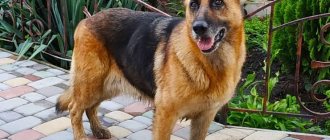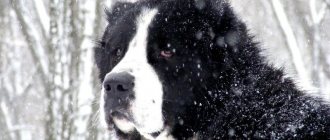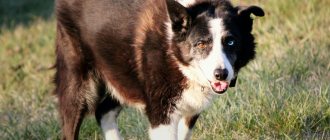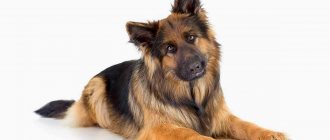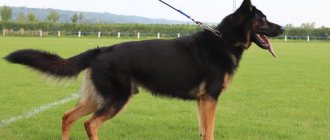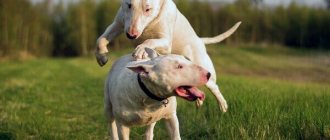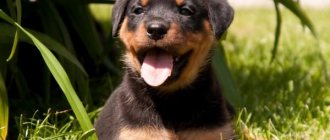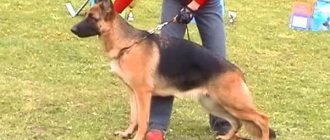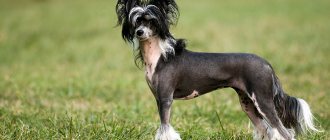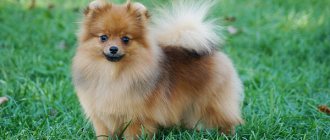Proud descendant of mastiffs. A perfectly built, large and beautiful dog that is suitable both as a reliable guard and as a true family friend.
This breed arose as a result of natural selection and a little human intervention. Establishing a uniform standard was difficult. Today there are a huge number of varieties of Alabai, differing in place of origin.
History of the origin of the breed
It is currently not possible to determine the exact pedigree of the Alabai, since the history of this breed goes back more than three thousand years. It owes its appearance to nomadic tribes engaged in cattle breeding in the territory from the Caspian Sea to Tibet. People needed a protector of herds from predators, and then presumably the first alabai appeared - dogs of extraordinary physical strength and endurance, capable of coping with a wolf due to their physical superiority and fearlessness.
The Turkmens have a legend that describes intelligent, cunning, treacherous and vindictive animals of enormous size - syrtlons. According to legend, they lured domestic dogs, resulting in unusual puppies. Perhaps the legend is talking specifically about the alabai, since these animals are distinguished by highly developed intelligence and independence. But at the same time they are very devoted to a person and quickly become attached to him.
The closest relatives of such dogs are the Tibetan Mastiff and the Mongolian Shepherd. They were intended primarily to protect the nomad's family and were valued as highly as war racehorses. Selection work on the breed began in the 1930s. It was assumed that Alabais would replace other dogs in guarding industrial facilities, but this idea was abandoned due to difficulties in training a wayward animal.
Varieties of alabai according to place of “registration”
Turkmen Central Asian Shepherd Dogs are characterized by a proportional build.
These are strong and hardy pets with very fast reactions and a high pain threshold.
Photo 1. Alabais are big and smart dogs
Like other shepherd dogs of this breed, Turkmen dogs are characterized by high intelligence.
Tajik Central Asian Shepherds are distinguished by their heavier external shape, which makes them look like St. Bernards. These dogs are also characterized by a longer coat.
Alabaev, originally from Uzbekistan , is distinguished from the rest by his shorter stature and “lighter” external constitution. These representatives of shepherd dogs are already closer to greyhounds and show greater activity and endurance.
Kazakh Alabais are classic representatives of Central Asian Shepherds as we imagine them.
The appearance of these large dogs causes many people unfamiliar with the detailed description of the breed to confuse them with St. Bernards, Caucasian Shepherds, Bernese Mountain Dogs or Moscow Watchdogs...
Varieties of Alabaev
Wolfhound subspecies have been selected in almost all Asian countries. They have some differences, depending on their habitat, but family ties are clearly visible.
Here are the most famous types:
- Tibetan mastiff. A rare and expensive dog that can survive in harsh conditions. Mastiffs are tall and powerful, with thick hair in the neck area that extends into the mane. They are calm, with a rather gentle character and love children, but you should not leave them alone.
- The Turkish Kangal is one of the most ancient breeds. Very obedient, kind, hardy and brave, but at the same time distrustful. Gets along well with other pets. Most often used for protection.
- The Uzbek Buribasar stands out from other Asians due to its smaller size and elongated muzzle. An easy-going dog with developed intelligence.
- The Siberian Alabai is a cross between a German Shepherd and a Siberian Husky. Obedient, smart and sociable.
- The Afghan Alabai is very strong and is often used for hunting. It is not recommended to keep him with other pets. Extremely willful, takes a long time to get used to people.
- The Alaskan Malamute is wolf-like in appearance, hardy and friendly, but can be stubborn. Dogs are used to transport goods, and not as guards, because they are absolutely devoid of aggression.
- The German Alabai is a cross between an Indian wolf and a German dog. Very smart, senses danger, fearless and mentally stable.
- The Armenian Gampr has a distinctive external feature – powerful jaws. He becomes very attached to a person if he proves his dominance.
- Kazakh tobet is the least common today and is on the verge of extinction. They are strong and unpretentious.
- The Kyrgyz debit is another endangered species of alabai. In the eighties of the last century, they were actively destroyed because they were considered spreaders of rabies.
- The Tajik Alabai is the largest and resembles a St. Bernard, good-natured and reserved.
The Turkmen Alabai is taken as the basis for the characteristics of the modern factory breed. Most of all, he is similar in psychotype to another representative of wolfhounds - the Caucasian Shepherd Dog. It is impossible to say with certainty which of them is stronger. Alabais are slightly larger and more massive, but less stubborn and aggressive. Here it is worth taking into account the tasks set by breeders when creating breeds. If a Caucasian is aimed at destroying the enemy, then the shepherds rejected dogs that attacked the owner. Asians are characterized by a clear division into friends and foes.
The Alabai breed standard was first registered only in 1989. In 2010, changes were made to it, in particular, the maximum permissible height of a shepherd dog was increased by 5 cm. Currently, Alabais are in demand in the security field, so very stringent requirements are imposed on selection and training.
Walks and meals
If you need a dog to walk along the alley on a leash, then the Alabai is definitely not suitable. The physical characteristics of the dog require great stress. In order for him to grow strong, resilient and harmonious, he needs constant loads in the form of jogging, descents and ascents. For Alabais kept in an apartment and suffering from a lack of space and physical activity, many hours of double walks in the fresh air is a way out of the situation.
Both natural and factory-made food are acceptable for feeding the Central Asian Shepherd. If you prefer to feed your pet with ready-made food, then you should give only premium products. With a natural diet, you need to balance the supply of nutrients, so the diet should include lean meat, boiled sea fish, cereals, vegetables, some offal, kefir, and cottage cheese.
Breed standard - dimensions
The Central Asian Shepherd is one of the twenty largest dogs in the world. Alabais grow quite quickly in height up to six months, and from 6 months they become wider and reach a height of 60-66 cm and a weight of 45 - 50 kg. By nine months, puppies are approaching the size of a sexually mature individual, but continue to gain muscle mass. Males of this breed reach full maturity by the age of three. At this point, the working shepherd dog reaches a height of 70 cm at the withers. Females are somewhat smaller - up to 69 cm at the withers.
The acceptable parameters for the weight of an adult Alabai are as follows:
- from 50 to 80 kg for males;
- from 40 to 65 kg in females.
But there are also larger individuals - up to 90 cm (males). The standard allows this if the proportions of the body are preserved.
Performance check
In the modern understanding of the working qualities of dogs, the main purpose of the breed is protection and protection, and this is what is meant when they talk about the working qualities of the Central Asian Shepherd Dog. Dogs that are unable to fight back against a two-legged or four-legged opponent are not considered true wolfhounds and should not take part in breeding, no matter what titles they may have. To evaluate the working qualities of the Central Asian Shepherd Dog, in a number of places of primordial breeding, fights were held according to clearly established rules that excluded injuries or death of dogs. In modern history, these events were called “Wolfhound Tests”. Wolfhound testing is a test of the breed's character, fortitude and physical qualities.
Today, the guarding qualities of the Central Asian Shepherd are the most sought after in the breed. However, not every dog has an innate ability to guard, and it is passed on only genetically
Alabai's character
Appearance
Alabais have a strong, powerful, proportionally built body without excess fat. The back and chest are wide, well developed, with pronounced muscles. The rise from the high withers to the croup is smooth. The stomach should be taut. The coat of the Central Asian Shepherd is hard and straight with a fairly thick undercoat. In the long-haired species it reaches 10 cm, in the short-haired species it reaches up to 5 cm. A mane is possible on the neck. The skin is elastic, thick and mobile - this allows you to wriggle out of the enemy’s teeth.
Acceptable colors are the following:
- pale yellow;
- black;
- white;
- grey;
- brindle;
- ginger;
- brown.
Spotted colors (for example, black and white) are acceptable; blue and chocolate coat colors are considered rejected. The tail of the Alabai is sickle-shaped, thick and set high. A ring shape is acceptable. Some puppies are born with a stubby tail.
The ears of the Central Asian shepherd are medium in size and set at (or slightly below) the level of the eyes. Four types of ears are acceptable:
- undocked;
- medium length with a straight or semicircular cut;
- bear. This shape suggests elongated cartilage with a rounded cut;
- Caucasian, in which a third of the ear cartilage is preserved. It is better suited for long-haired dogs.
The head of a purebred Alabai should be powerful and proportional to the body, square or rectangular in shape, with a wide, massive jaw. The nose is black. In whites and other light colors, lighter skin is acceptable. The paws are straight, of medium length, with wide bones and pronounced muscles. The pads of the limbs are dense and hard.
Alabai's eyes are round in shape and widely spaced. The color of the cornea is any shade of brown; blue eyes are considered a fault. The look of a healthy dog is expressive, confident and stern. This is a genetically inherent feature that characterizes the Alabai.
Varieties of colors and coat types
To explain what Central Asian Shepherd dogs look like, you need to show photographs of them. A variety of coat colors are available and acceptable: white, black, black and white, red, brindle, gray, spotted, white and red. The most common are snow-white ones; they are popularly called albinos, although they are not such.
The tiger-colored Alabai makes a special impression; this coat color in the human subconscious creates an even greater fear of the power of such dogs. Tibetan white alabai are valued less than others, but they are the most widespread.
Alabais come in two types of coat: smooth-haired and long-haired. These species can mate with each other, but long-tailed owners are not willing to make such deals.
Central asian shepherd dog
Character
During the selection process, the Alabai developed the main quality - the ability to stand up for itself and those it protects. These skills make the Central Asian an excellent shepherd and fighter, but it is not suitable for everyone as a pet. The Shepherd Dog from Central Asia has a very aggressive temper and tends to dominate. Separately, it is worth noting the nobility of this breed. It lies in the reluctance to finish off a defeated opponent. Therefore, only those who know nothing about the character of an Asian can say that a pit bull terrier will easily defeat an Alabai. A shepherd dog, of course, can instantly deal with such an opponent due to its physical advantage, but as soon as it sees that the pit bull is weaker, it simply stops the fight.
Alabai requires professional training from a very early age. It is highly undesirable for a beginner in dog breeding to own a dog of this breed!
Alabai, without proper training, rushes at any strange dogs. He is neutral towards those who live with him. It usually does not attack people, but is wary of strangers. A wolfhound will not bite a stranger unless he poses a threat. It is sensitive to the mood of the owner and his family members, so this breed is not suitable for cruel people with an unstable psyche.
Central Asian Shepherds treat children much better than Caucasians, especially those with whom they live in the same territory. A competently trained Alabai is a reliable friend of the owner, very attached and devoted to him. This is a strong and brave dog, which does not rush into a fight unnecessarily. In addition, she is very hardy and unpretentious in everyday life.
Alabai with family
In the family circle, the Alabai turns into a sweet, flexible pet who adores you and your family with all his heart.
These are very cheerful and active pets who will not let themselves or you get bored. These dogs love to frolic and fool around while walking, where, preferably, there should be no other dogs.
Photo 5. Central Asian dogs get along well with pets
Central Asian Shepherds know very well what exactly belongs to him and his owner. “Asians” are calm about cats and even other dogs with whom they grew up and were raised.
They will with all their dedication protect not only you, but also your garden from attacks by geese or sheep.
Their intelligence allows them to calculate with mathematical precision the distance a predator (or threat) is “allowed” to approach.
When a predator crosses this invisible border, the alabai literally breaks loose and uses its entire “arsenal” to eliminate the threat.
Intelligence allows “Asians” to maintain self-confidence regardless of the situation.
Care and maintenance
The Central Asian Shepherd is very easy to care for, feed and maintain. Especially when used for its intended purpose - protecting a house or grazing livestock. Alabai wool is resistant to dirt and does not need frequent washing. Usually the dog is bathed on the eve of the exhibition. It is recommended to comb the animal a couple of times a week. Central Asians shed all year round, but especially heavily in the spring. If you take care of the coat, the undercoat will shed less.
Ideally, a dog of this breed should not live in an apartment, but in a yard or enclosure. You can't keep it on a chain. Alabais were created free and capable of making independent decisions. They need serious physical activity and long walks. Ears should be cleaned and inspected regularly. Dog breeders have different opinions regarding docking.
Cupping
Initially, the ears and tails of alabayas were cut off for safety reasons, so that in a fight with wolves they would be less vulnerable and would not receive unnecessary injuries with large blood loss.
In the homeland of the breed, ears are traditionally not cropped, but cut off. If you do this before the puppy is a week old, the scraps do not bleed and heal quickly. In other countries, this method is considered barbaric and is stopped more for aesthetic reasons.
In Central Asians, the nerve endings of the ears are inactive for up to 10 days, and the vertebrae are soft. Therefore, the little Alabai feels pain much less, anesthesia does not need to be used. Usually the procedure is carried out on the fifth day of the puppy’s life, subject to normal birth and the appearance of healthy babies. For dogs older than two weeks, surgery will be performed under anesthesia.
When cutting the tail, the main thing is that the cut is even. The ears must be cropped by a qualified specialist, since the coat of most Alabais is quite short. Flaws will be immediately visible and will ruin the dog’s appearance. The operation costs an average of 600–800 rubles.
Poor cupping or the consequences of errors during the rehabilitation period can only be corrected with a repeat operation.
In the first 10 days after trimming the ears and tail, the incision site must be treated with an antiseptic. Wash the place where puppies sleep thoroughly to prevent infection.
Older Alabai are given stitches, which are also removed on the tenth day. During this time, puppies need to wear plastic collars to prevent them from licking their wounds.
In most cases, Central Asians tolerate the procedure well. They feel quite comfortable in both heat and cold. The main thing is to properly organize their nutrition.
What to feed
Alabais are absolutely not picky about food. The main thing is to follow some feeding rules:
- You need two bowls - one for water, the other for food;
- fresh water should always be available;
- It is advisable to feed the dog at the same time, half an hour after a walk;
- you cannot overfeed the animal;
- bowls should be placed on a stand and adjusted as the puppy grows, so that he reaches upward for food, rather than leaning over it;
- After feeding, leftover food must be removed.
Regardless of whether an Asian eats dry food or home-cooked food, all food should be fresh and at room temperature.
Industrial food should be selected according to the age and size of the shepherd dog. If the dog is on a natural diet, be sure to include in the diet:
- meat (beef or veal);
- dairy products;
- oatmeal;
- egg;
- buckwheat;
- cottage cheese;
- sea fish;
- rice;
- bran;
- vegetables.
Offal can be given instead of meat, but not more than twice a week.
Give chicken with caution! Be careful not to get any tubular bones. This meat can also cause an allergic reaction.
You should not give your dog sweets, pork, or flour (except rye bread). In winter, Alabai should eat more carbohydrates and protein, and in summer, increase the amount of vegetables consumed.
Central Asian Shepherd – general features of the breed
Endurance is one of the distinctive features of Alabais. According to this indicator, they occupy third place, second only to St. Bernards and Newfoundlands. The harsh conditions in which the breed evolved have endowed Asian Shepherds with strength, thick hides, sharp intelligence and independence.
This is a balanced, calm and stubborn animal . But if the owner is in danger, he will react with lightning speed and do everything to protect him.
The weight of the largest alabai reaches 125 kg.
Medium sizes
Height:
- Males (70-78cm).
- Females (65-69cm).
Weight:
- Males (50-79kg).
- Bitches (40-65kg).
The length of the coat varies among different representatives: from short (3-5 cm) to long (10 cm). Regardless of length, the coat is thick, straight and harsh . There is a dense undercoat that saves dogs from overheating and hypothermia. Colors may also vary. According to standards, brown color interspersed with blue or gray is considered unacceptable. This also includes red “brick” color.
Advantages
- Good health.
- High intelligence.
- Unpretentiousness to living conditions.
- Devotion.
- Ideal watchman (protects people and property).
Flaws
Most of these features are leveled out by proper upbringing and competent socialization.
- Stubbornness and difficult character.
- Unpredictable reaction to a new environment.
- Aggression towards other dogs.
- The need for constant physical activity and training.
- Difficult learning process.
Diseases and life expectancy
Centuries-old selection has made the Alabai a surprisingly healthy and strong breed. In their homeland, shepherd shepherds kept only the best animals, and simply destroyed the rest, since it was expensive to maintain several dogs. The quality of the offspring became increasingly better.
This was greatly facilitated by the attitude of Asian shepherds to the health of their pets. There are known facts that any wounds to the dogs were sprinkled with ashes from the fire. When a dog was sick, it was burned with a hot iron between the eyes - it was believed that this would activate the body's defenses. For helminths they gave lamb skin with wool. The Alabai found the rest of the medicines on their own, eating the necessary herbs and roots.
As a result of this approach to selection and veterinary medicine, Central Asians received excellent health and the ability to resist infections and bad weather. However, some problems still exist. They are associated with the gigantic size of the dog.
Main diseases of Alabai:
- joint dysplasia is a likely consequence of the dog’s passive lifestyle;
- dislocations also occur quite often;
- arthrosis of various etiologies can appear due to poor nutrition;
- allergies are present in some representatives of this breed due to their very thick fur, in which it is difficult to detect parasites in time.
Particular attention should be paid to the Alabai bitch during estrus and pregnancy. Changes in hormonal levels cause behavioral changes. The dog may become more aggressive and anxious. A female should be closely monitored during her heat (especially the first one), because she tends to run away or get into a fight with other dogs. A reverse reaction can also be observed: the bitch becomes lethargic, walks reluctantly, and her lower abdomen hurts.
At the first signs of an animal’s discomfort, you should consult a veterinarian as soon as possible. Any symptom can be the result of various, sometimes life-threatening, diseases.
In some Alabai bitches, during empty heat (without mating), the vaginal mucosa swells greatly and comes out. If the animal has previously suffered an inflammatory disease of the digestive tract, complete vaginal prolapse may occur. This is more common in late pregnancy, but can also occur during estrus.
This disease requires the help of a specialist, because the prolapsed part of the vagina dries out, becomes injured and can lead to necrosis. During estrus, the part of the organ that is outside is washed and an antiseptic ointment prescribed by a veterinarian is applied. If this happens constantly or there is a possibility of infection, the prolapsed part is either reduced or surgically removed.
When a dog loses its voice
Central Asians are not among the empty-breed breeds, but still the dog can lose its voice or become hoarse. If the situation does not return to normal within a couple of days, you should urgently contact a veterinarian. The absence of barking can occur for many reasons, including dangerous diseases.
The most common of them:
- an abscess occurs as a result of foreign objects entering the throat, resulting in swelling or infection of the damaged area;
- laryngeal paralysis. The congenital form of this disease is typical for dogs of large breeds, including Alabais;
- polyps or malignant neoplasms;
- hypothyroidism;
- autoimmune diseases leading to dysfunction of the ligament muscles;
- cold infections.
Sometimes the reasons for a pet's muteness are lack of water or living in a house where there are strong odors (tobacco, paint, etc.). It is not possible to make a diagnosis on your own, so you should not postpone a visit to the veterinarian. Before this, you need to monitor the dog and ventilate the room more often if it lives in the house. Make sure the water in the bowl is always clean. You can carefully examine the larynx to see if there are any seeds, small particles or swelling.
If the cause of hoarseness is a foreign object in the throat, you should not try to remove it yourself! This may increase injury.
Sometimes antihistamines help dogs with swelling. The dosage should be calculated by the doctor, depending on the drug and the weight of the animal. In any case, you will have to visit the veterinarian regularly in order to take timely measures to treat fleas, ticks or worms. You should also strictly follow the schedule of preventive vaccinations.
Vaccination
The puppy must be vaccinated at the time indicated in the vaccination schedule. This will reduce (or completely eliminate) the risk of contracting dangerous infections.
Here is an approximate vaccination calendar in the form of a table:
| Puppy age | Vaccine |
| 3−4 weeks | first PUPPY vaccine (necessary if there are several animals in the house) |
| 8−10 weeks | leptospirosis plague hepatitis parainfluenza enteritis (first vaccination) |
| 11−13 weeks | rabies (first vaccination) leptospirosis plague hepatitis parainfluenza enteritis (second vaccination) |
| 6−7 months | rabies (second vaccination) leptospirosis plague hepatitis parainfluenza enteritis (third vaccination) |
| 12 months | leptospirosis plague hepatitis parainfluenza enteritis (fourth vaccination) |
Next, revaccination is done with a complex drug, as well as annual rabies prevention.
Before taking your puppy for vaccination, you need to make sure that he is completely healthy.
After the procedure, you need to follow a few simple rules:
- do not bathe the animal;
- do not overwork;
- You cannot walk the puppy immediately after vaccination.
Alabais are among the longest-livers. With proper and attentive care, their average life expectancy is from 12 to 15 years, which is unusually long for such a large dog. In addition to health, it is very important to socialize your shepherd dog on time.
Feeding
Central Asian Shepherds do not eat as much as they might seem. Feeding a pet comes down to creating a diet “according to needs.” It is important to understand that, given the high energy content, food should not contain large amounts of carbohydrates (especially for young dogs). Diet adjustments are made by monitoring weight gain; obesity is an extremely undesirable disease that has a detrimental effect on the dog’s joints and heart.
The best option is natural feeding , that is, meat, cereals, vegetables and fruits. Usually, Asians are given moslaks, but not as food, but as a toy. Fish is not that important, but ocean varieties are rich in trace elements and essential amino acids. Dairy products are useful, provided that the dog itself wants to consume them and does not experience stomach upset afterwards.
Important! It is necessary to regularly include vitamin supplements in the natural diet.
Feed can be considered as an alternative. Naturally, the products should be designed for large and fast-growing breeds. Until the age of 3, the pet should receive food with a strengthened composition. Product class is not lower than premium, for puppies and old dogs, not lower than super-premium.
Training
Alabai need to be raised from three months of age, devoting at least 20 minutes a day to this process. All family members should take part in the process of education, and only one should feed - the owner of the shepherd dog. You can train a dog at home, but it is better to contact an instructor. A nine month old puppy should know and follow basic commands. If a small Alabaik, while playing, tries to bite the legs, arms or clothes, this must be stopped, but you should not wave it away, scream or run away. The baby will perceive this behavior as a game. You should freeze in place, firmly say the command fu and leave. Do not allow the dog to dominate; you should be affectionate, but strict. If a task has been given, it is necessary to ensure its precise implementation.
Puppy training should be interesting. Also, we must not forget about encouragement - it can be not only a tasty morsel, but also affection and verbal approval. It is very important for Alabai to realize that the owner is happy with him. It is important to achieve the main thing - so that the dog calmly gives its owner its food. This will mean that the person is recognized by her as the main one. If a grown-up Alabai bites its owner, it means that it has not completed a competent training course and feels like the leader of the pack. If you raise him with excessive cruelty, aggression in adulthood will become a defensive reaction. It is very difficult to re-educate an Alabai. Therefore, those who do not have experience with dogs should not choose this breed.
During the training process, it is important to remember that Asians are very vindictive and touchy. Beating an animal is unacceptable; the maximum that can be done is to lightly hit the shepherd dog (while it is very small) on the nose with a rolled-up newspaper, but so that the movement is imperceptible.
You can't hit a dog with your hand! Alabai should not perceive the owner as an enemy.
Another aspect that should be given special attention is to teach calm communication with other dogs, without depriving the pet of such contacts. If everything is done correctly, then there is an opportunity to get a calm and devoted friend, a reliable security guard.
How much does alabai cost?
There are a number of objective and subjective factors that determine the cost of an Alabai puppy. These include:
- exterior. Experts distinguish between excellent, good, simple and very simple. The price gradation is directly proportional to the assessment;
- signs (or lack thereof) of tribal marriage. This should be of greater concern to those who plan to participate in exhibitions or want to become a breeder. A dog with a plembrace is not suitable for this application. And don’t even doubt that he can become just a good friend and a reliable guard for you;
- puppy coat color. White alabai will cost much more.
The cost may also be affected by where the breeder lives. Statistics show that in Moscow and the region prices are higher than in the periphery.
Contrary to popular belief, the size of the puppy does not particularly affect the price. Nature alone knows what exactly your pet will be like as an adult.
The average prices for small Alabais start from 15 thousand rubles - most often these dogs have a breed, puppies of a simple exterior will cost in the range of 15-20 thousand rubles, for an Asian “with a future” you will have to pay at least 30 thousand rubles.
Remember that the puppy must have correct registration documents. Without them, it’s just a dog that looks like an Alabai. If you just love animals and want to make a loyal friend, then this warning is not for you. In the end, the degree of love, affection and loyalty has never been measured by the presence of this or that, even the most important, paper.
Choosing a puppy – where to buy and price
It is best to purchase a puppy from specialized nurseries (Dar Asia, Klovi, Shakhriyar) or from a breeder. Before buying, observe the behavior of his parents and evaluate their appearance. It is better to take Alabai when slightly older (at the age of 1.5-2 months). The first vaccinations should already be done.
You should also pay attention to the following points:
- eyes and ears should be clean and nose moist;
- throw some object on the floor (for example, a bunch of keys) and choose the puppy who is not afraid of a loud sound, but shows interest in a new thing - he will run up and start sniffing;
- A purebred Alabai has a teardrop-shaped head, the transition from the muzzle to the back of the head is smoothed;
- the puppy's chest looks wide;
- the front legs are straight, you can fit a palm between them;
- the puppy's tail is raised up and docked;
- if there are small children in the house, it is better to buy a female; if you need a guard, it is better to buy a male.
You should not buy an Alabai with long hair - it is a cross with a Caucasian. A real Central Asian looks like a plush toy. You should not choose a dog at the market or based on an ad on the Internet. The puppy may turn out to be a reject, a mixed breed, or just a mongrel. The worst thing is that such a dog cannot exclude the possibility of physical or mental pathology. There should be no problems finding an Alabai, since the breed is quite popular. The price of a good purebred puppy ranges from 20,000 to 45,000 rubles.
How to choose an Asian Shepherd puppy
So, after weighing all the pros and cons, you have firmly decided to get an Alabai and even decided on the gender of your future pet. But this does not mean that you have to rush to the first kennel you come across to pick up a dog. Purchasing a Central Asian Shepherd is a responsible process, so you need to seriously prepare so as not to buy yourself a big problem from an unscrupulous breeder.
First you need to get advice from a specialist, or better yet, go with him to the nursery. Before choosing a specific candidate, look at several litters. If the opportunity arises, visit a dog show.
Before buying a puppy, pay attention to the following aspects:
- breeder's reputation;
- living conditions for parents and children;
- appearance of puppies and adult dogs (does external data correspond to breed standards);
- on the behavior and visual health of offspring;
- for the presence of metrics and certificates for children.
It is recommended to purchase puppies that are at least 7 weeks old. Consider active, moderately curious, non-fearful and non-aggressive fluffies as potential candidates. The kittens must have the correct bite and good appetite. There is no need to choose the largest or smallest specimen, even if you liked one of them.
Pros and cons of the breed
It is clear, as in everything and everywhere, this breed has its pros and cons, and it is still unknown what is more here.
The advantages of Alabaev are usually called:
- devotion,
- goodwill,
- outstanding security abilities,
- physical endurance,
- minimal time and financial costs for care, and so on.
And of the minuses -
- the need for a large area for comfortable living,
- regular increased physical activity, which means daily exercise with your pet, including in special areas, long walks, etc.
- incompatibility with four-legged fellows,
- heavy shedding,
- unpredictability in an emergency.
Health
The life expectancy of the Central Asian Shepherd varies between 12–15 years. If we are talking about non-purebred or too “refined” individuals, the lifespan is reduced to 8–10 years. Breed diseases, or more precisely, a tendency to them, is a very flexible and individual concept. Dogs of the indigenous species, living in seemingly harsh conditions, are prone only to joint dysplasia, and then only in extreme old age. The “improved” breed type, and especially mixed breeds, have a predisposition to:
- Almost all diseases of the joints and bones - dysplasia of the elbow and hip joint, arthritis, arthrosis, myositis, tendonitis. The reasons are an unbalanced diet, low mobility, lack of vitamins and microelements.
- Dogs living in apartments or on a chain lead an inactive lifestyle, which leads to cardiac arrhythmia, and in old age, to myocardial infarction. The second and no less common cause of heart attack is obesity.
The risk of genetic, that is, hereditary anomalies is also important. In families with mixed blood, the following ailments occur:
- Disruption of the endocrine system - hypothyroidism, too short or poor coat, various deformities of build (overgrown, too small individuals, bitch-type males).
- Missing teeth.
- Too light eyes and ophthalmological problems, especially cataracts and glaucoma.
- Cryptorchidism.
An insidious deviation that is difficult to notice is infertility or the absence of actual sexual heat in females. The dog goes into heat according to the standard pattern, but during the period of intense rutting, the bitch does not allow the male to come near her. The situation repeats itself from year to year, although outwardly the bitch looks absolutely healthy.
If the owner does not get his bearings in time and does not sterilize the pet, the threat of pyrometra - purulent inflammation of the uterus - increases sharply. The pathology requires serious treatment (at an early stage) or surgical intervention. If this situation is missed, the dog dies.
Puppies up to 3 months of age are protected by the mother's immune system, and after that they become very vulnerable to viral diseases. The situation is complicated by the fact that Alabais mature up to 2–3 years. Despite new opinions and the supposed unnecessaryness of vaccinations, the dog needs to be vaccinated, and strictly according to schedule.
In addition to the standard set (rabies, canine distemper, leptospirosis, viral hepatitis), it is recommended to vaccinate the dog against piroplasmosis and adenoviral infections (infectious tracheobronchitis and parainfluenza).
